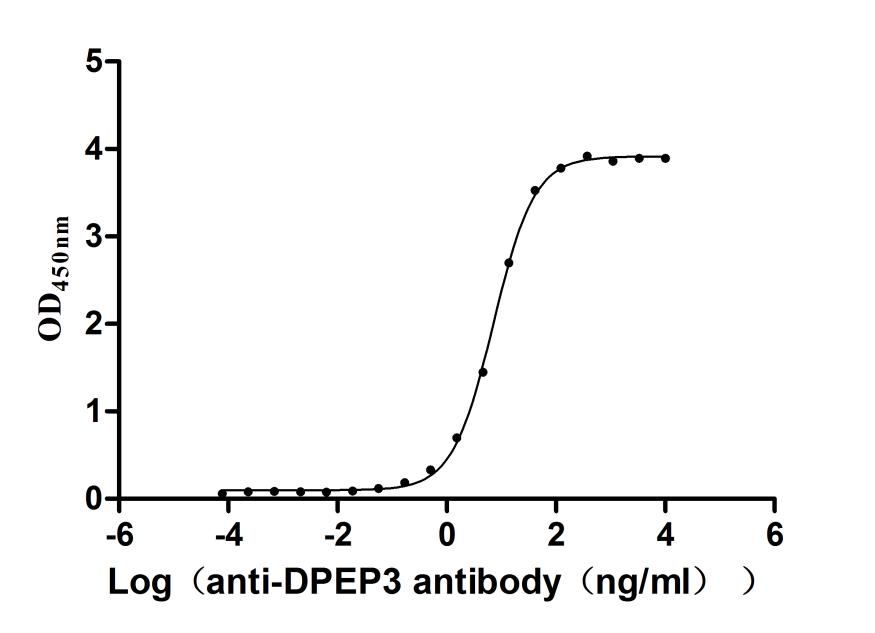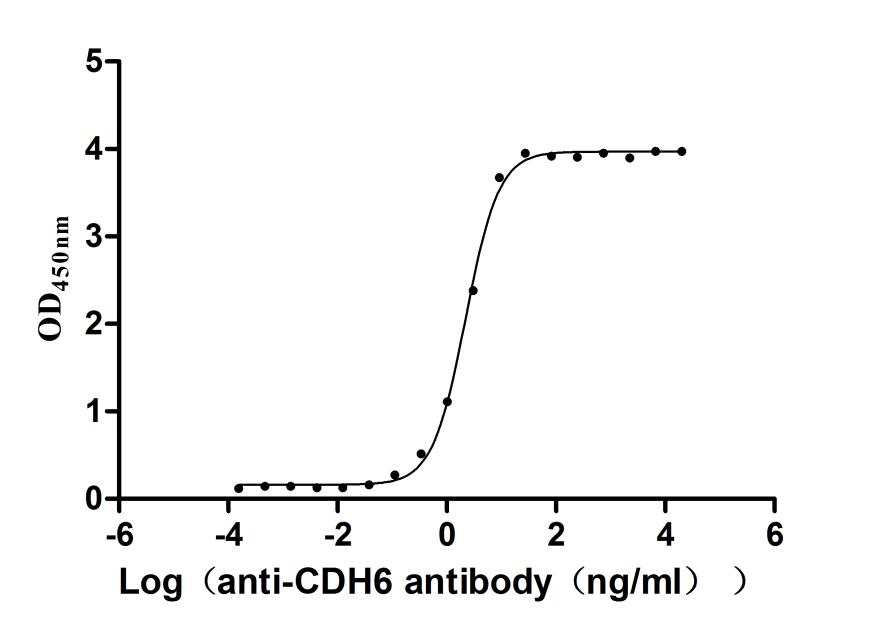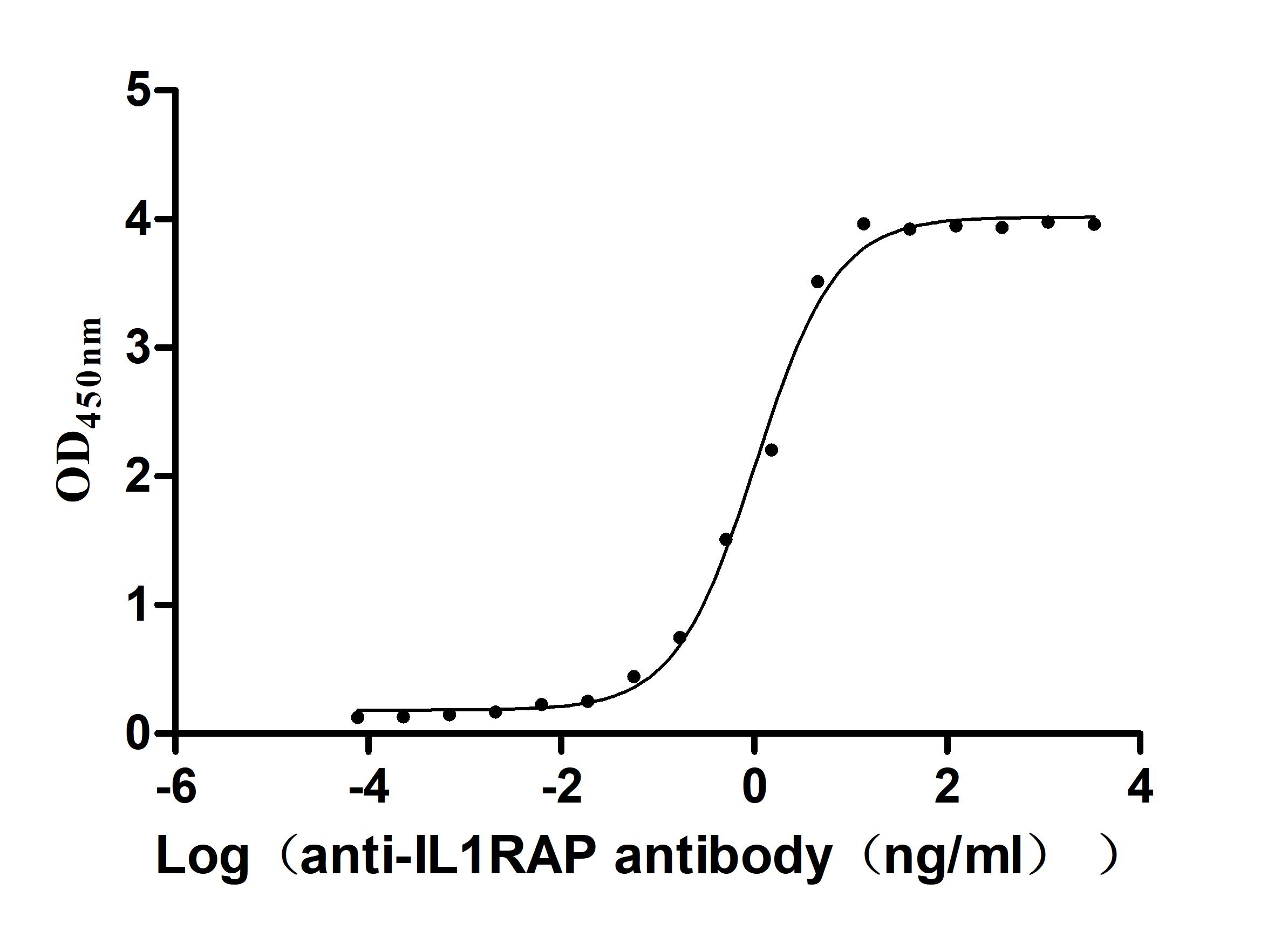Recombinant Human Complement component C1q receptor (CD93), partial
-
货号:CSB-YP865099HU
-
规格:
-
来源:Yeast
-
其他:
-
货号:CSB-EP865099HU
-
规格:
-
来源:E.coli
-
其他:
-
货号:CSB-EP865099HU-B
-
规格:
-
来源:E.coli
-
共轭:Avi-tag Biotinylated
E. coli biotin ligase (BirA) is highly specific in covalently attaching biotin to the 15 amino acid AviTag peptide. This recombinant protein was biotinylated in vivo by AviTag-BirA technology, which method is BriA catalyzes amide linkage between the biotin and the specific lysine of the AviTag.
-
其他:
-
货号:CSB-BP865099HU
-
规格:
-
来源:Baculovirus
-
其他:
产品详情
-
纯度:>85% (SDS-PAGE)
-
基因名:
-
Uniprot No.:
-
别名:C1q receptor 1; C1q/MBL/SPA receptor; C1qR; C1qR(p); C1qr1; C1QR1_HUMAN; C1qRp; CD93; CD93 antigen; CD93 molecule; CDw93; Complement component 1 q subcomponent receptor 1; Complement component C1q receptor; dJ737E23.1; ECSM3; Matrix remodeling associated protein 4; Matrix remodelling associated 4; Matrix-remodeling-associated protein 4; MXRA4
-
种属:Homo sapiens (Human)
-
蛋白长度:Partial
-
蛋白标签:Tag type will be determined during the manufacturing process.
The tag type will be determined during production process. If you have specified tag type, please tell us and we will develop the specified tag preferentially. -
产品提供形式:Lyophilized powder
Note: We will preferentially ship the format that we have in stock, however, if you have any special requirement for the format, please remark your requirement when placing the order, we will prepare according to your demand. -
复溶:We recommend that this vial be briefly centrifuged prior to opening to bring the contents to the bottom. Please reconstitute protein in deionized sterile water to a concentration of 0.1-1.0 mg/mL.We recommend to add 5-50% of glycerol (final concentration) and aliquot for long-term storage at -20℃/-80℃. Our default final concentration of glycerol is 50%. Customers could use it as reference.
-
储存条件:Store at -20°C/-80°C upon receipt, aliquoting is necessary for mutiple use. Avoid repeated freeze-thaw cycles.
-
保质期:The shelf life is related to many factors, storage state, buffer ingredients, storage temperature and the stability of the protein itself.
Generally, the shelf life of liquid form is 6 months at -20°C/-80°C. The shelf life of lyophilized form is 12 months at -20°C/-80°C. -
货期:Delivery time may differ from different purchasing way or location, please kindly consult your local distributors for specific delivery time.Note: All of our proteins are default shipped with normal blue ice packs, if you request to ship with dry ice, please communicate with us in advance and extra fees will be charged.
-
注意事项:Repeated freezing and thawing is not recommended. Store working aliquots at 4°C for up to one week.
-
Datasheet :Please contact us to get it.
相关产品
靶点详情
-
功能:Receptor (or element of a larger receptor complex) for C1q, mannose-binding lectin (MBL2) and pulmonary surfactant protein A (SPA). May mediate the enhancement of phagocytosis in monocytes and macrophages upon interaction with soluble defense collagens. May play a role in intercellular adhesion.
-
基因功能参考文献:
- Report increased CD93 expression in patients with chronic plaque psoriasis and propose the C allele of rs2749817 as a new risk allele for psoriasis. PMID: 28421233
- Results show that CD93 and MMRN2 are co-expressed in the blood vessels of various tumors and their interaction modulates the angiogenic process. PMID: 28912033
- These findings identify novel protein interactions involving CLEC14A, CD93 and CD248 with MMRN2 as targetable components of vessel formation PMID: 28671670
- CD93 and Other Plasma Cell Survival Factor Genes Associated with Measles-Specific Antibody Response after Vaccination PMID: 27529750
- Soluble expression of disulfide-bonded C-type lectin like domain of human CD93 in the cytoplasm of Escherichia coli. The recombinant protein could alter LPS pro-inflammatory activity on THP1 cells. PMID: 27742562
- Vascular CD93 expression is elevated in nasopharyngeal carcinoma and is correlated with T classification, N classification, distant metastasis, clinical stage and poor prognosis (all P < 0.05). In addition, overexpression of CD93 promoted angiogenesis in vitro. PMID: 27255994
- both transmembrane and soluble CD93 are overexpressed in patients with neovascular Age-Related Macular Degeneration. PMID: 27859225
- Elevated serum sCD93 levels reflected exacerbated status of allergic diseases, including CSU [chronic spontaneous urticaria ], AR[allergic rhinitis], and asthma. ICS [inhaled corticosteroid] use significantly diminished serum sCD93 levels in steroid-naive patients with BA[Bronchial asthma]. This result may suggest sCD93 in serum as a therapeutic marker for allergic inflammation. PMID: 28332366
- Data show that CD93 antigen proved to be phosphorylated on tyrosine 628 and 644 following cell adhesion on laminin through dystroglycan. PMID: 26848865
- CD93 expression identifies a predominantly cycling, non-quiescent leukemia-initiating cell population in MLL-rearranged AML, providing opportunities for selective targeting and eradication of LSCs. PMID: 26387756
- The T/T genotype of SNP rs2749817 of CD93 is associated with disseminated cancer. PMID: 26008729
- CD93 is a key regulator of glioma angiogenesis and vascular function, acting via cytoskeletal rearrangements required for cell-cell and cell-matrix adhesion. PMID: 26363010
- These data support a mechanism whereby gC1qR plays an important role in HPV-16 E2-induced human cervical squamous carcinoma cell apoptosis via a mitochondria-dependent pathway. PMID: 25288439
- The data indicate that gC1qR inhibits viability, migration and proliferation of cervical squamous cells carcinoma via the p38 MAPK signalling pathway. PMID: 23052251
- Antibody-dependent enhancement of parvovirus B19 involves an alternative mechanism mediated by the heat-sensitive complement factor C1q and its receptor, CD93. PMID: 24807719
- Expression of CD93 on the lymphocyte population of peripheral blood cells from infants at 1 month after birth was also significantly decreased, compared with that for neonatal umbilical cord blood. PMID: 24033555
- HPV 16 E2 induces apoptosis by silencing the gC1qR gene or inhibiting p38 MAPK/JNK signalling in cervical squamous cell carcinoma PMID: 23651874
- These data support a mechanism whereby gC1qR induces apoptosis through the mitochondrial and p53-dependent pathways in cervical squamous cell carcinoma. PMID: 23268996
- soluble EGF-like domain containing CD93 protein is a novel angiogenic factor acting on the endothelium PMID: 23272129
- [review] Following a comprehensive summary of CD93 expression patterns, this review focuses on recent findings that address the putative function of CD93 in inflammation and innate immunity. PMID: 22206251
- Data show that Pic, a class 2 SPATE protein produced by Shigella flexneri 2a targets a broad range of human leukocyte glycoproteins including CD43, CD44, CD45, CD93, CD162 and the surface-attached chemokine fractalkine. PMID: 21768350
- Results suggest that the plasma concentration of soluble CD93 is a potential novel biomarker for Coronary Artery Disease (CAD), including MI. PMID: 21332844
- expression on naive T lymphocytes (CD4(+)CD45RA (+) cells) in human neonatal umbilical cord blood PMID: 20512406
- both B1 receptor and gC1q receptor are involved in the vascular leakage induced by hereditary and acquired angioedema plasma. PMID: 19796797
- To clarify the cellular and molecular properties of C1qRp it has been demonstrated that C1q does not show enhanced binding to C1qRp-transfected cells, is not a receptor for C1q, and is identical to CD93 with functions relevant to intercellular adhesion. PMID: 11994479
- C1qRp defines a new human stem cell population with hematopoietic and hepatic potential PMID: 12140365
- O-glycosylation is important in the stable cell surface expression of C1qRP/CD93 PMID: 12891708
- Taken together, these findings indicate that the expression of the CD93 molecule identified by CD93 mAb (mNI-11) is dramatically decreased on U937 cells with apoptotic properties PMID: 18094537
- RNAi-mediated suppression of gC1qR/p32 markedly reduced HTNV binding and infection in human lung epithelial A549 cells PMID: 18834607
显示更多
收起更多
-
亚细胞定位:Membrane; Single-pass type I membrane protein.
-
组织特异性:Highly expressed in endothelial cells, platelets, cells of myeloid origin, such as monocytes and neutrophils. Not expressed in cells of lymphoid origin.
-
数据库链接:
HGNC: 15855
OMIM: 120577
KEGG: hsa:22918
STRING: 9606.ENSP00000246006
UniGene: Hs.97199
Most popular with customers
-
Recombinant Human Tumor necrosis factor receptor superfamily member 5 (CD40), partial (Active)
Express system: Mammalian cell
Species: Homo sapiens (Human)
-
Recombinant Macaca fascicularis Membrane spanning 4-domains A1 (MS4A1)-VLPs (Active)
Express system: Mammalian cell
Species: Macaca fascicularis (Crab-eating macaque) (Cynomolgus monkey)
-
Recombinant Human Dipeptidase 3(DPEP3), partial (Active)
Express system: Mammalian cell
Species: Homo sapiens (Human)
-
Recombinant Macaca fascicularis Cadherin 6(CDH6),partial (Active)
Express system: Mammalian cell
Species: Macaca fascicularis (Crab-eating macaque) (Cynomolgus monkey)
-
Recombinant Macaca fascicularis Interleukin 1 receptor accessory protein(IL1RAP), partial (Active)
Express system: Mammalian cell
Species: Macaca fascicularis (Crab-eating macaque) (Cynomolgus monkey)

















